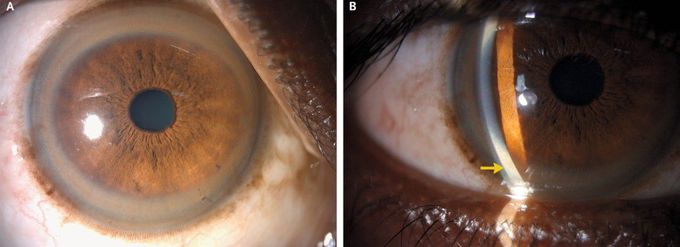


Kayser–Fleischer Rings in Wilson’s Disease
A 47-year-old man with no known medical history presented to the department of internal medicine with a 2-month history of abdominal distention and melena. He did not drink alcohol or take any medications or supplements. Physical examination was notable for ascites, pedal edema, gynecomastia, postural tremor, and mild cognitive impairment. During the physical examination, pigmented rings were observed in both corneas (Panel A), and copper deposition was observed in Descemet’s membrane on slit-lamp examination (Panel B, arrow). Both findings were consistent with Kayser–Fleischer rings. Laboratory studies showed mild elevations in serum levels of aminotransferases and total bilirubin, a prolonged international normalized ratio, and a normal alkaline phosphatase level. The serum ceruloplasmin level was 3.1 mg per deciliter (reference range, 14 to 40), the serum copper level was 5 μmol per liter (reference range, 10 to 22), and the 24-hour urinary copper excretion was 382 μg (reference range, 10 to 30). Genetic testing revealed a compound heterozygous mutation in ATP7B, the gene encoding a copper-transporting ATPase, and a diagnosis of cirrhosis due to Wilson’s disease was made. Treatment with trientine and zinc for copper chelation was started, and the patient was listed for liver transplantation.

